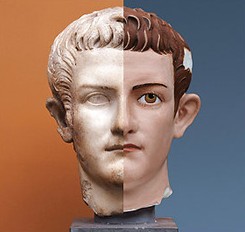Thanks mostly to a Renaissance aesthetic notion, we’ve come to imagine ancient Greece and Rome as places of stark beauty—pure white marble temples filled with pale statues. Though it’s not a surprise to archaeologists and art historians, many of us more pedestrian folk can be stunned to learn that the clean, dignified marble statues and edifices of ancient Greece were actually painted with bright colors, making them look more like miniature golf course decorations than serene relics of antiquity. (Granted, high dollar miniature golf course decorations, but still…)
The fact is, a plain white statue would have seemed unfinished to the ancient Greeks. Some ancient writers mention or describe techniques for finishing statues with pigments and other substances. Here’s Plato, for instance, comparing properly organizing a city to painting a statue:
It is as if we were coloring a statue and someone approached and censured us, saying that we did not apply the most beautiful pigments to the most beautiful parts of the image, since the eyes, which are the most beautiful part, have not been painted with purple but with black—we should think it a reasonable justification to reply, ‘Don’t expect us, quaint friend, to paint the eyes so fine that they will not be like eyes at all, nor the other parts. But observe whether by assigning what is proper to each we render the whole beautiful.’
 From other sources, it seems that painting a statue was taken as a matter of course—statues were made to imitate living people, and painting and other finishing techniques were the final stage in bringing a statue to life. Not coloring a statue would have been the odd thing to do. Those mythological story book illustrations of Pygmalion standing back admiring his just-carved girlfriend should probably depict him holding a paintbrush, and not a set of chisels.
From other sources, it seems that painting a statue was taken as a matter of course—statues were made to imitate living people, and painting and other finishing techniques were the final stage in bringing a statue to life. Not coloring a statue would have been the odd thing to do. Those mythological story book illustrations of Pygmalion standing back admiring his just-carved girlfriend should probably depict him holding a paintbrush, and not a set of chisels.
Anyway, bouncing back into the Web’s collective consciousness comes an exhibit of recolored ancient statuary called “Gods in Color: Painted Sculpture of Classical Antiquity,” that was making the rounds in 2007–2008. It features the results of the scientific/artistic work of Vinzenz Brinkmann, who had evidently been studying tool-marks on ancient carvings and realized that the lights he was using to bring out the marks were also highlighting textures, lines, and patterns that had once been painted on. Combine this technique with microscopic analyses of remaining flecks of pigment to determine the colors, and you develop a pretty good idea of the missing colors and designs.
The result of the reconstructions is fascinating, not only from an artistic perspective, but from the way it forces you to re-imagine the mental images of ancient classical civilization that might be floating around in your mind. It takes some effort to throw out the beige stone and white temples, and replace them with blazing colors.
Here are some sites with pictures and more information:
- Boston.com: “Sculpture show of a different color”
- ColourLovers: “Gods In Color: Painted Sculpture Of Classical Antiquity”
- The Wall Street Journal: “Setting the Record Straight About Classical Statues’ Hues”
- Arthur M. Sackler Museum: The Gods in Color Gallery Guide (PDF)
- Stiftung Archäologie Projekte: The original project site, in German